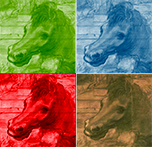Hyperspectral imaging is a chemical imaging technique based on reflectance spectroscopy (the light reflected by materials). This device makes the collection of reflectance spectra in each point of the field of view for the Near Infrared range (it is complementary to another device for the visible range). The hyperspectral image cube obtained can be considered both as a stack of wavelength-resolved images and as a series of spectra. The near infrared spectra consist of vibrational overtones and combination absorption features where spectral signatures can allow to identify and map different materials. Near Infrared hyperspectral imaging is a non-invasive, in situ technique that allows to collect data cube in few minutes without any preparation of the artwork.
Fields of application
-
Cultural heritage
archaeological object and site, architecture, art, decorative arts, demo anthropologic object, film, manuscript, mosaics, musical instrument, painting, photo, sculpture, textile
Materials
-
inorganic
ceramic (clay/mud brick/terracotta/earthenware/stoneware/porcelain), glass, stone, metal and metallurgical By-Products
-
organic
animal parts, binding media, glues, wood, paper, textiles, varnishes
TOOLS

The system consists of an ImSpector N25E imaging spectrograph (Specimcorp, Finland) and a cooled, temperature stabilized MCT detector (9.6 mm detector having 320 (spatial) x 256 (spectral) pixels). The camera operates from 970 to 2500 nm with a spectral resolution of 10 nm. It works as a line scan camera providing full, contiguous spectral data...
